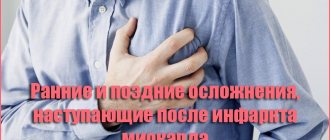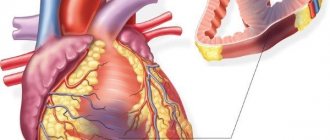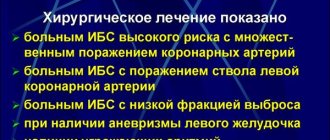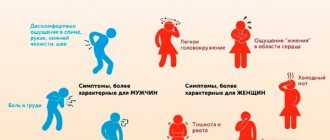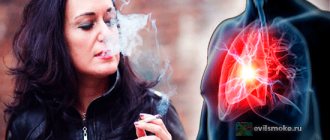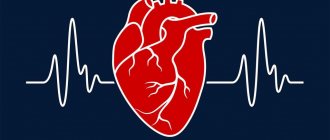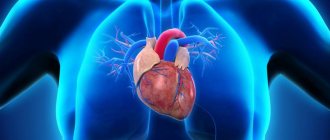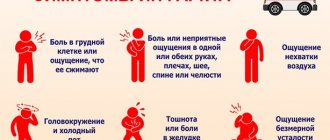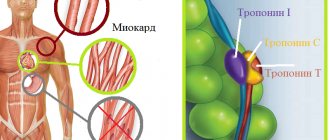5 / 5 ( 2 voices)
The article describes various conditions that complicate myocardial infarction. Symptoms and principles of treatment are described. Myocardial infarction is the destruction of the muscle cells of the heart. This condition is irreversible; the heart tissue is not restored. A scar remains at the site where necrosis occurred. Accordingly, the heart cannot fully perform its function. This leads to the development of complications of myocardial infarction.
Necrosis of the heart muscle is accompanied by various complications
Causes
The entire disease process occurs rapidly, but the factors that provoke a heart attack last for years. If you identify them in time, you can take certain preventive measures in order to protect yourself from a heart attack of the thigh muscle. Poor circulation is one of the main causes of hip infarction. However, there are other reasons:
- joint damage;
- severe damage due to which the arteries are twisted or compressed;
- blockage of a blood vessel by a thrombus;
- taking steroid hormones that regulate various physiological processes in the body (metabolism, growth, reproductive functions);
- systematic consumption of alcoholic beverages;
- radiation;
- acquired or chronic diseases: pancreatitis, diabetes mellitus, osteomyelitis (purulent-necrotic process caused by bacteria);
- sickle cell anemia (a hereditary disease in which the structure of the hemoglobin protein is disrupted).
One case out of three is so unique that specialists are unable to determine the cause of a muscle tissue infarction in the thigh area.
Treatment of myocardial infarction in a hospital setting and first aid at home
Myocardial infarction is today the leading cause of death from cardiac pathology, so emergency treatment of this disease becomes a matter of life and death. And given the characteristics of myocardial infarction at a young age, any lost minute can change the entire course of treatment.
If pain occurs in the heart area, breathing problems or blood pressure problems, you must immediately call an ambulance. Necrosis of the heart muscle takes from 1 to 3 hours. This interval is fundamental in saving the patient’s life.
As a form of self-help, you need to lay the patient down, provide access to oxygen and choose the most gentle regimen until the doctors arrive. As for medications, it is recommended to take 2 - 3 tablets of Nitroglycerin. A good way to stop an attack of angina is to take 35 - 45 drops of Corvalol or Corvaldin.
Some experts suggest applying a cold heating pad to the heart area to reduce the rate of inflammation, however, modern medicine does not have a definite opinion on this matter.
After admission to the hospital, the patient is hospitalized in the intensive care unit, where the main stage of stopping cardiogenic shock or pulmonary edema is carried out. The treatment of such conditions has been worked out by doctors and includes a set of measures to support the patient’s vital functions and reduce necrosis of the heart muscle.
The following comes to the fore in the treatment of acute myocardial infarction:
- pain relief;
- saturating the patient's body with oxygen.
In modern conditions, there are enough ways to relieve pain during a heart attack, including therapeutic anesthesia with nitrous oxide and epidural anesthesia. Conventional narcotic analgesics in combination with tranquilizers and antipsychotics form the basis for relieving pain in myocardial necrosis.
Infusion therapy is required to raise and stabilize blood pressure. The use of various plasma substitutes and medium-molecular dextrans makes it possible to centralize blood circulation, avoid the occurrence of tissue edema, and contribute to sufficient productivity of the kidneys.
To reduce the area of necrosis, anticoagulant therapy is mandatory, where, along with the well-known drugs Heparin and Fibrinolysin, the latest generation of drugs based on streptokinase are used. In extreme cases, intra-aortic balloon counterpulsation may be performed to save a young life.
If treatment of the acute period of myocardial infarction is successful, then the rehabilitation period after such a disease ranges from 6 months to 1 year, including sanatorium treatment and exercise therapy at the place of residence.
We recommend reading the article about drugs for treatment after myocardial infarction. From it you will learn about prescribed medications, the effects of drugs, and the prescription of maintenance therapy after a heart attack.
Symptoms of thigh muscle infarction
The cessation of blood supply to the affected area develops rapidly, which significantly affects the patient’s movements. Among the main symptoms of the disease are:
- acute pain in the hip joint that does not stop even at night;
- increased pain when walking, which radiates to the knee, buttock or lower back;
- severe lameness;
- a high likelihood of atrophy or wasting of the quadriceps femoris muscle;
- the length of the affected lower limb decreases, as well as the volume of muscle tissue on it;
- it is difficult for the patient to move his leg to the side and put on socks and shoes independently;
- change in skin color;
- peeling of the skin is a problem, the appearance of blisters and erosion on it.
The main signs of a heart attack in men
Contents: [hide]
Myocardial infarction is a serious disease that is classified as an emergency. In cardiac diseases, infarctions occupy an entire branch and are among the most dangerous conditions, the prognosis of which depends on the severity of myocardial damage, the accuracy of the diagnosis, and the speed of providing emergency measures to localize the lesion. In men, heart attacks are recorded more often than in women, while hemorrhagic strokes affect women more often than men. In connection with morbidity statistics, the number of deaths currently in first place comes from myocardial infarctions, cerebral infarctions and hemorrhagic strokes. This statement shows the degree of threat of damage to the myocardium of the heart.
If you take a closer look at the work of the heart, you can distinguish several stages in it. The heart is divided into four chambers, the contraction of which in the required sequence allows blood to be pumped through the small and large circles, which is a generalized process of the functioning of the body. The heart muscle, called the myocardium, contracts throughout a person's life and determines the functioning of the heart. Lack of blood supply to the myocardium itself leads to a heart attack, that is, to an irreversible change in muscle fiber cells.
Signs of myocardial infarction
The first signs of a heart attack have some features that occur in most men as the disease process progresses. The most common of them are:
- sharp and cutting pain in the middle of the chest or at the level of the tie (sometimes called tie pain);
- profuse cold sweat, especially on the extremities;
- pallor of the skin, especially in the area of the nasolabial triangle;
- quite often there is an increased pulse, up to 130 beats per minute and above;
- shortness of breath, inability to take a full breath.
The given signs are general and are found in the clinic of heart attacks in the vast majority of cases. However, complaints were recorded in men of pain in the lower jaw or even pain in the right side of the chest, pain in the stomach area (epigastric region).
It should be noted here that classic chest pain usually does not raise questions, especially since the condition is aggravated by shortness of breath, high pulse and weakness. Usually, if these indicators are present in men, people around them call an ambulance. If the pain is characterized as aching, radiates to the back and chest, but at the same time does not cause noticeable pain reactions, then patients most often endure it, while drinking painkillers, blurring the picture of the disease even more. As a result of delay in taking urgent measures, the likelihood of a favorable outcome sharply decreases.
2-3 days after the onset of the first signs, a sharp deterioration in well-being occurs, as a result of which it is no longer possible to provide effective assistance.
Symptoms of myocardial infarction may be similar to those of angina pectoris - sharp pain in the chest and shortness of breath. Under no circumstances should you wait until the pain goes away, even in patients with a history of angina pectoris. There is an empirically derived time for the release of an attack of chest pain. It is approximately 20 minutes. It is important to take 1-2 tablets of nitroglycerin at the very beginning of chest pain. If the pain does not go away within 20 minutes, urgent medical attention is required. When relieving pain, you still need to be examined by a cardiologist.
Only a cardiologist can establish the truth of a heart attack in men using objective and clinical indicators. Therefore, in the event of pain in the chest, shortness of breath, cold sweat, or pain radiating to the throat or jaw, adequate measures should be taken in the form of taking nitroglycerin as soon as possible and calling an ambulance. The patient should lie down or sit down if possible. Any movements are extremely undesirable, as they will cause additional stress on the myocardium of the heart.
Importance of emergency care
Any heart attack that disrupts the flow of blood through the coronary vessels can result in a heart attack. Factors that are based on the problem of atherosclerotic changes inside the vessels can contribute to its occurrence. The growth of lipid plaques on the inner walls of the coronary vessels leads to their gradual blockage. As a result, blood flow through them decreases, which leads to angina pectoris and coronary heart disease.
For some reason, a plaque can break away from the wall of the vessel; at the site of the tear, the process of blood clotting occurs, followed by the formation of a blood clot. A thrombus can completely block a coronary vessel and the myocardial area is no longer supplied with fresh blood carrying oxygen. Within a few minutes, the gradual process of death of myocardial cells begins, and a colossal threat to life ensues. Therefore, time to provide emergency assistance is valuable. If signs of a heart attack are confirmed by an ECG (electrocardiogram), there is very little time left before assistance is provided. Under ideal conditions, assistance should be provided within the first 40-60 minutes from the onset of symptoms. But this is not always possible.
Real help with signs of a heart attack and their proof is thrombolysis therapy. The relevance of its implementation is the first 6 hours from the onset of symptoms. The decision to conduct it is made by a cardiologist based on the patient’s medical indicators. Relatives or acquaintances of a patient with a second heart attack should inform the doctor about the thrombolysis therapy performed earlier, since repeated therapy has certain time limits and, accordingly, is not always possible.
Prevention and risk reduction
Prevention of myocardial infarction in men consists of a healthy lifestyle, proper nutrition, and control of the lipid complex. The modern rhythm of life and not always proper nutrition have led to the fact that the age of men and the risk of developing a heart attack have decreased and are approximately 40 years old. Therefore, upon reaching this age, careful monitoring of well-being is necessary. Any signs of shortness of breath, mild pain, especially after physical exertion, should be alarming, therefore, when the latter appear, ECG monitoring at rest and under load is required.
In the case of obvious atherosclerotic changes on the walls of the vessel, more complex studies are performed in the form of coronary angiography, and based on its indicators, the doctor decides to perform coronary stenting.
In conclusion, I would like to note the important relationship between the speed of emergency care and the likelihood of a favorable prognosis in the future.
Diagnostics
Many specialists make a big mistake when they send patients for x-rays at the first manifestations of the disease. However, X-ray examination reveals pathological changes in the thigh muscle only in the later stages. If the doctor focuses only on this analysis, he may miss time, which is so important for the patient. After all, an early detected disease can be stopped. And at a later stage, only surgery will help.
Today, the most effective diagnostic methods are magnetic resonance and computed tomography, which can recognize the course of the disease at the earliest stages. Sometimes they do the usual blood tests and ultrasound, but they absolutely cannot confirm a muscle tissue infarction. These diagnostic methods are appropriate when identifying any other pathology that may be one of the causes of thigh muscle infarction.
Risk groups: influence on the incidence of gender, age and place of residence
In recent years, there has been an increasing number of cases of myocardial infarction in young patients. The most vulnerable group of the population is men from 40 to 60 years old. In the age group of 40-50 years, heart attacks in men develop 3-5 times more often than in women, which is explained by the action of female sex hormones, one of the actions of which is to strengthen the vascular wall. Once women enter menopause (50 years and older), the incidence of the disease becomes the same in them and in men.
Most often, myocardial infarction occurs in men 40–60 years old.
In young patients, the cause of myocardial infarction is most often heart defects and coronary arteries; in older patients, atherosclerotic changes in the coronary vessels are most often the cause.
Women more often than men develop an atypical form of myocardial infarction, which often leads to untimely detection of the disease and explains the more frequent development of adverse consequences in them, including death.
Residents of industrialized countries and large cities are more susceptible to the disease, which is explained by their greater exposure to stress, frequent dietary errors and less favorable environmental conditions.
If there is no blood supply to the heart muscle for more than 20 minutes, irreversible changes occur in it caused by cell death, which negatively affects the functioning of the organ.
Treatment of pathology
Treatment methods for muscle tissue infarction depend on the stage of development of the disease. Typically, this pathology is treated with medication, without surgery. The main goal of therapy is to restore impaired blood circulation in the affected part of the thigh. The attending physician prescribes various medications to the patient that promote the restoration of damaged tissue:
- oral: anti-inflammatory and vasodilator drugs;
- local application: cream, ointment;
- massage and therapeutic exercises;
- hirudotherapy;
- symptomatic treatment (for example, taking analgesics for sudden and severe pain).
The affected limb must be completely immobilized, as activity can cause hemorrhage in the affected area. At the first stage of the disease, it is recommended to walk as little as possible and always use a cane. Perform strength exercises daily to prevent muscle atrophy (reduction in the volume and weight of functioning tissues). When drug therapy does not produce positive results, then surgical intervention is required. Thanks to the operation, the blood supply to the area affected by the infarction increases and the pain subsides.
Types of complications
The most common complications experienced by patients after a heart attack are:
- acute or chronic heart failure;
- arrhythmia;
- heartbreak;
- aneurysm;
- thromboembolism;
- secondary attack.
Each of these complications has its own characteristics of development and course. Let's look at them in more detail.
Heart failure
During a heart attack, part of the myocardial tissue dies, so the heart cells in the damaged area can no longer contract. This impairs the functions of the organ, causing a person to develop acute heart failure.
This condition can manifest itself in the form of pulmonary edema or cardiogenic shock. Characteristic manifestations of the complication will be wheezing, shortness of breath, lack of air, severe pain in the heart, and pressure surges.
As a result of shock, a person may experience impaired consciousness and hypotension.
With prolonged impairment of the contractile functions of the heart, the patient may develop a chronic form of myocardial failure. This disease will constantly progress and worsen blood circulation.
The complication is manifested by the following symptoms:
- weakness,
- dizziness,
- shortness of breath even at rest,
- pain in the right hypochondrium,
- swelling in the evening,
- accumulation of fluid in the abdominal cavity.
Arrhythmia
If a heart attack affects the part of the heart muscle in which the conduction pathways are located, a person may experience arrhythmia. Moreover, rhythm disturbance can occur due to the influence of metabolic changes observed during an attack.
The most severe are ventricular and atrial fibrillation, as they can cause acute heart failure and death.
Important! Heart rhythm disturbances are not always early complications. Arrhythmia can be caused by medical therapy, when a person is given special drugs that dissolve a blood clot in a blocked vessel. This leads to the resumption of blood circulation and a sharp change in heart rate.
Heartbreak
Heart rupture is a real complication that occurs when there is a defect in the myocardium that occurs after an attack. This area will contain dead tissue with altered properties. Gradually it will become vulnerable to tension and will be susceptible to destruction.
Typically, cardiac rupture is observed with a severe heart attack 5-6 days after the attack. This complication can be internal or external. With such changes, the patient can only be helped by urgent surgery.
Unfortunately, due to compression of the heart and severe damage to it, this complication is usually fatal, and the person dies within a few minutes.
Aneurysm
An aneurysm is a pathological protrusion of one of the myocardial walls after a heart attack. This is usually an early complication that occurs in the first days after an attack.
It is very difficult to treat an aneurysm, since it affects the walls of the myocardium. In such a condition, a person will need to be extremely careful throughout his life so as not to cause the aneurysm to rupture.
Thromboembolism
A heart attack provokes severe pathological changes in a person. As a result, after an attack, the patient’s tendency to form blood clots increases. There may also be a circulatory disorder, which will only worsen due to the patient’s immobility in the first days of the illness.
In this condition, a person may develop blood clots. They are usually localized in the cavity of the left ventricle.
When there is a surge in blood pressure, which often occurs in hypertensive patients, such blood clots can clog the vessels, causing thromboembolism. This can lead to a second heart attack or stroke. Damage to small arteries threatens an attack of angina.
Treatment of this condition should be carried out with the use of drugs that thin the blood and prevent the formation of blood clots. Otherwise, the patient's condition may worsen.
Abdominal syndrome
This complication often occurs not only after a heart attack, but also after other serious pathologies.
Abdominal syndrome has the following manifestations:
- abdominal pain,
- bloating,
- stomach ulcers,
- elevated temperature,
- stool disorder.
Secondary infarction
In those patients who suffer from an advanced form of atherosclerosis or a tendency to form blood clots, the development of a secondary infarction is observed shortly after the first attack.
Due to the fact that the body has not yet had time to recover from the consequences of the attack, a secondary heart attack leads to much more serious complications.
Forecast
This disease has a very favorable prognosis. Therefore, you should not be upset, since a person’s poor psycho-emotional state can negatively affect the process of his recovery. It all depends on the severity of the identified illness and the further actions of the attending physician. You need to be confident in a favorable outcome and focus all your efforts on recovery. If the disease is ignored for a long time, it can lead to osteoarthritis (a chronic disease of the joints and cartilage) or muscle contracture. The latter disease is characterized by a limited range of motion in the joint.
In order for the process of restoring arterial patency to produce positive results, it is necessary to use drip systems (intravenous). Most often, men aged 20-45 years are affected by the disease. As a rule, the disease affects only one leg, less often - two. The body always gives us a hint, we just need to be able to recognize it. After all, the onset of the disease can be reduced to nothing, which cannot be said about the final stages, when only surgical intervention is indicated. Therefore, pay attention to the signals of your body, worry about your health, this way you will prevent the occurrence of pathological changes in the muscle tissue of the thigh.
Classification
Complications of myocardial infarction - classification divides them into early and late. The earlier the complication developed, the more severe it is.
Early complications of myocardial infarction include those that develop in the first 7-10 days:
- cardiogenic shock;
- acute heart failure, or pulmonary edema as a complication of myocardial infarction;
- arrhythmia.
Late complications of myocardial infarction are those conditions that develop after a few weeks:
- Dressler's syndrome;
- chronic heart failure.
In any post-infarction period, cardiac aneurysm and coronary artery thromboembolism may occur. Early and late complications of myocardial infarction develop with different frequencies. Let's look at this using a diagram as an example.
Incidence of heart attack complications
The consequences after a heart attack depend on the type of heart attack, its prevalence, and what concomitant pathology the person has.
Types of heart attack suffered on the legs
The manifestation of signs of the disease is proportional to the extent of damage to the heart muscle. If they are small, then we are talking about microinfarctions, and the individual does not feel serious ailments, but attributes a slight deterioration in his condition to banal fatigue. Doctors in this situation say that the patient suffered an attack on his legs. In cases where a man has suffered a heart attack on his legs, it is possible to detect a scar at the site of the affected muscle only through a hardware examination carried out for a different reason. The asymptomatic course of the disease is its atypical form. Doctors distinguish the following types of heart attacks on the legs:
- Combined or erased - the individual experiences a slight tingling in the chest area, rapid fatigue, and increased sweating.
- Brain or cerebral - manifested by loss of orientation, speech impairment, and disruption of blood flow.
- Gastrological or abdominal - the clinic manifests itself from the digestive system. There is intolerance to certain odors, bloating and aching pain in the lower abdomen, nausea and vomiting.
- Arrhythmic necrosis - the heart seems to stop, the pulse quickens.
- Shock or collaptoid - pressure drops quite sharply, against the background of which appears fainting, tinnitus, dizziness.
- Asthmatic - it is characterized by coughing attacks, the inability to breathe deeply, and shortness of breath. In this case, there is no pain.
The most difficult form of the disease to analyze is the combined form of the disease, the consequences of which become apparent after some time. The greatest danger lies in cerebral infarction, since as a result of speech problems the individual cannot say what is happening to him. It is almost impossible to detect an atypical heart attack, so any situation in which your health changes is a reason to seek help from doctors.
Preventing another heart attack
In the acute period of a heart attack in men at the age of 40, and at other ages, it is necessary to follow a strict diet, as this will help avoid a recurrence of the attack and prevent the occurrence of consequences. It is recommended to enrich the diet with the following products:
- fruits;
- pasta;
- vegetables;
- various cereals;
- seafood;
- greens;
- berries;
- nuts;
- dried fruits;
- lean meat and fish;
- diluted broths.
Reception is prohibited:
- smoked meats;
- strong tea, coffee, alcohol-containing drinks;
- fatty varieties of fish and meat products;
- sausages
It is also advisable to limit the use of salt as much as possible.
Dietary nutrition must be observed both during the period of treatment and rehabilitation, and in the future.
In addition to changing the diet, the individual should:
- give up addictions forever;
- avoid physical and mental stress;
- bring your weight back to normal;
- follow the drinking regime recommended by the doctor;
- perform physical exercises;
- take daily walks in the fresh air in all weather conditions;
- regularly monitor blood pressure;
- be constantly monitored by a cardiologist;
- take medications prescribed by a specialist.
It is important to remember that failure to follow the above recommendations, lack of preventive measures, as well as untimely contact with doctors can lead to rupture of the heart muscle, heart failure, cardiogenic shock and cause death.
Consequences
The very fact of having a silent heart attack increases the risk of relapse, and a second heart attack will most likely be more severe and more dangerous than the first. To reduce this risk, your doctor will strongly recommend that you make lifestyle changes. These include:
- heart healthy diet
- weight loss
- minimizing stress
- regular physical activity
- to give up smoking.
In case of a second heart attack, the symptoms may differ from those described. Be that as it may, if you have even the slightest suspicion, call a doctor. Early detection and treatment are key to survival.
Complications after a heart attack
An extensive heart attack in men (the reasons for its occurrence were described above) has serious consequences. If the patient does not receive specialized care within 24 hours after a heart attack, irreversible processes will occur. In addition, it can cause difficult-to-treat pathological conditions. Therefore, it is very important to undergo an examination after a rehabilitation course in order to identify complications caused by a heart attack at an early stage. Most often doctors diagnose:
- arrhythmia;
- swelling of lung tissue;
- myocardial rupture;
- pericarditis;
- sometimes paralysis of limbs;
- mental disorders;
- blood clot formation;
- heart block.
Some of the disorders can be corrected with medication or surgery. And the irreversible consequences are cardiac arrest and death of the individual.
Stages of extensive infarction
There are several stages of this disease:
- Prodromal or pre-infarction state - lasts from several hours to a month, depending on the individual characteristics of the body. The patient has persistent angina.
- The most acute - takes from thirty to one hundred and twenty minutes. The individual feels severe pain in the chest area and breaks out in a cold sweat. The heart rhythm is unstable, the pressure drops.
- Acute – from three to ten days. An area of dying tissue forms in the myocardium. Body temperature rises, arrhythmia is observed, pain dulls.
- A scar is formed. During this stage, which lasts four to five weeks, blood pressure and heart rate return to normal.
- Post-infarction or last – from three to six months. The heart adapts to work in new conditions.
